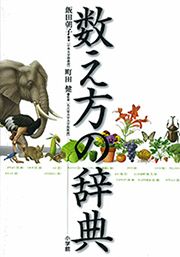JapanKnowledge

This unique dictionary allows you to experience the richness of Japanese "counting culture," by looking up how a given object is counted from its name.
This innovative dictionary contains words used to count things. Japanese has an incredible variety of words used to count objects. For example, the word sao is used to count chest-of-drawers, the word hara is used to count cod roe, the word hari is used to count mosquito nets, and the term tomae is used to count storehouses. This dictionary shows what counter suffixes can be used for approximately 4,600 words that are used in everyday life, as well as other nouns that are used like counter suffixes. It goes beyond simply showing counting words, but provides explanations on how to use them, as shown by these examples.
| Examples: | The word zen is used to count pairs of chopsticks, but it is not used for saibashi and hibashi tongs, even though they are called chopsticks. The word ko is used to count cardboard boxes when there is something inside them, but the word mai is used to count them when they are folded up. |
Additionally, for each of the 600 counter suffixes or nouns that act like counter suffixes, definitions and examples of usage are provided. This is quite different from what can be found in Japanese language dictionaries.
| Example : | Usage of do is more restricted than kai. (from a column) The words dai, zen, and kei cannot be placed before do. So for example, it is possible to say zen 10-kai drama but not zen 10-do drama. |
Also, the dictionary makes it easy to see whether traditional Japanese, Chinese, or English numerals can come before a counter suffix.
Many special columns give answers to questions such as "why is the counter hai used for squid and crabs?" By examining Japan's "counting culture," you can enjoy the richness, depth, and fascination of Japanese linguistic expression.
Author: Iida Asako
General editor: Machida Ken
General editor: Machida Ken
Contents information
| Original books | 数え方の辞典 |
|---|---|
| Publisher | SHOGAKUKAN Inc. |
| Publication date | April 1, 2004 |
| Number of volumes | One volume |
| Book price | ¥2,420 (Pre-tax price ¥2,200+tax10%) |
| Release date | February 28, 2006 |
| Number of entries | 5,200 entries |
| Number of characters | 260,000 characters |
| About search | ― |
| Frequency of update | ― |
| Available services |
(as of April 2014)